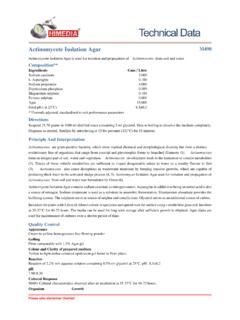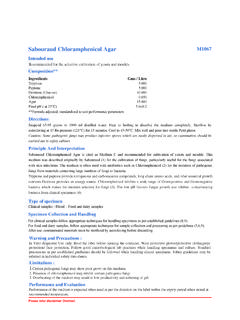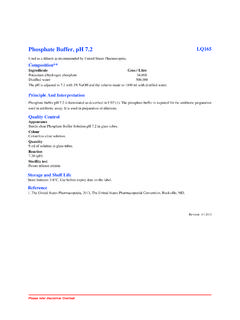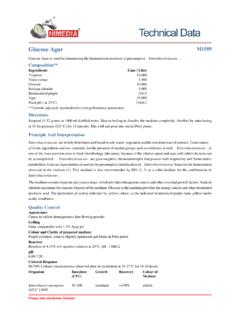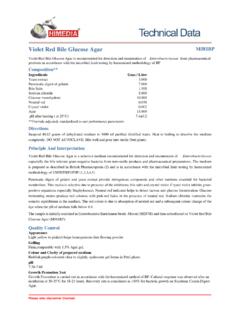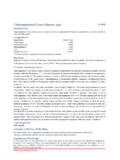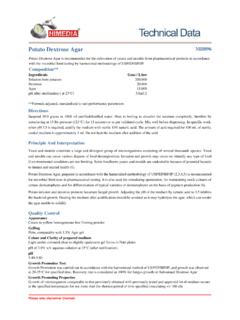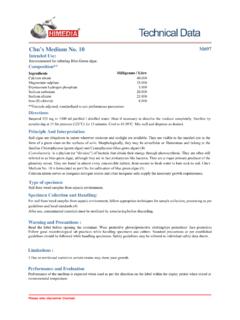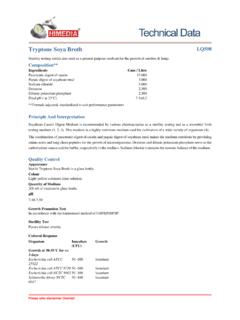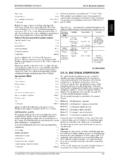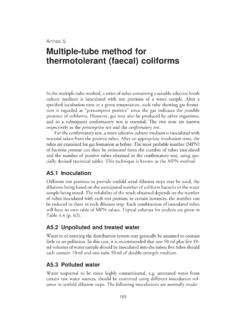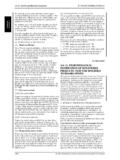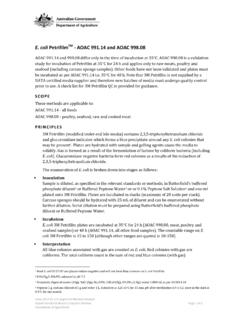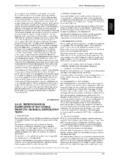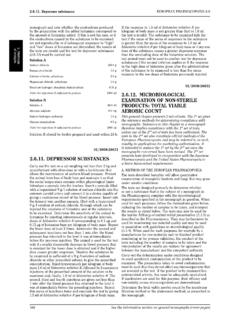Transcription of Urea Agar Base (Christensen)(Autoclavable) - …
1 Please refer disclaimer agar base ( christensen )( autoclavable )M112 Intended Use: urea agar base with the addition of urea is recommended for the detection of urease production, particularly by members of the genus Proteus .Composition**IngredientsGms / (Glucose) pH ( at 25 C) **Formula adjusted, standardized to suit performance parametersDirectionsSuspend grams in 950 ml distilled water. Heat to boiling to dissolve the medium completely. Sterilize by autoclaving at 10 lbs pressure (115 C) for 20 minutes. Cool to 45-50 C and aseptically add 50 ml of sterile 40% urea Solution (FD048) and mix well. Dispense into sterile tubes and allow to set in the slanting position. Do not overheat or reheat the medium as urea decomposes very And InterpretationUrea agar is used to detect urease production. urea agar described by christensen (1,4) detected urease activity by all rapidly urease-positive Proteus organisms and also by other members of Enterobacteriaceae (1) that exhibited a delayed urease reaction (2).
2 This was accomplished bya) adding glucose to the mediumb) decreasing the peptone concentration , andc) decreasing the buffering system, as a less buffered medium detects even smaller amount of alkali (3).Peptone is the source of essential nutrients. Dextrose is the energy source. Sodium chloride maintains the osmotic equilibrium of the medium whereas phosphates serve to buffer the medium. urea is hydrolyzed to liberate ammonia. Phenol red indicator detects the alkalinity generated by visible colour change from orange to incubation may cause alkaline reaction in the medium. A medium without urea serves as negative control to rule out false positive results. Also, all urea test media rely on the alkalinity formation and so they are not specific for determining the absolute rate of urease activity (2). The utilization of proteins may raise the pH to alkalinity due to protein hydrolysis and excess of amino acids liberation results in false positive reactionType of specimenPure isolate from samplesSpecimen Collection and HandlingFor clinical samples follow appropriate techniques for handling specimens as per established guidelines(8,9).
3 For food and dairy samples, follow appropriate techniques for sample collection and processing as per guidelines(5,6,10). For water samples, follow appropriate techniques for sample collection, processing as per guidelines and local standards(7). After use, contaminated materials must be sterilized by autoclaving before LaboratoriesTechnical DataPlease refer disclaimer and PrecautionsIn Vitro diagnostic use only. Read the label before opening the container. Wear protective gloves/protective clothing/eye protection/face protection. Follow good microbiological lab practices while handling specimens and culture. Standard precautions as per established guidelines should be followed while handling clinical specimens. Safety guidelines may be referred in individual safety data incubation may cause alkaline reaction in the , all urea test media rely on the alkalinity formation and so they are not specific for determining the absolute rate ofurease activity (2).
4 The utilization of proteins may raise the pH to alkalinity due to protein hydrolysis and excess of amino acids liberation results in false positive and EvaluationPerformace of the medium is expected when used as per the direction on the label within the expiry period when stored atrecommended ControlAppearanceLight yellow to light pink homogeneous free flowing powderGellingFirm, comparable with agar gelColour and Clarity of prepared mediumYellowish orange coloured clear to slightly opalescent gel forms in tubes as slantsReactionReaction of w/v aqueous solution at 25 C. pH : ResponseCultural characteristics observed on addition of sterile 40% urea Solution (FD048) after an incubation at 35-37 C for ResponseOrganismInoculum(CFU)UreaseCultu ral ResponseEscherichia coli ATCC25922 (00013*)50-100negative reaction, no change# Klebsiella aerogenes ATCC 13048 (00175*)50-100 Klebsiella pneumoniae ATCC 13883 (00097*)50-100positive reaction, cerise colourProteus mirabilis ATCC2593350-100 Proteus vulgaris ATCC1331550-100 Salmonella Typhimurium ATCC 14028 (00031*)50-100 Storage and Shelf LifeStore below 30 C in a tightly closed container and the prepared medium at 2 - 8 C.
5 Use before expiry date on the label. On opening, product should be properly stored dry, after tightly capping the bottle in order to prevent lump formation due to the hygroscopic nature of the product. Improper storage of the product may lead to lump formation. Store in dry ventilated area protected from extremes of temperature and sources of ignition Seal the container tightly after use. Use before expiry date on the label. Product performance is best if used within stated expiry : *Corresponding WDCM numbers. # Formerly known as Enterobacter aerogenesnegative reaction, no changepositive reaction, cerise colourpositive reaction, cerise colournegative reaction, no changeHiMedia LaboratoriesTechnical DataDisposalUser must ensure safe disposal by autoclaving and/or incineration of used or unusable preparations of this product. Followestablished laboratory procedures in disposing of infectious materials and material that comes into contact with clinicalsample must be decontaminated and disposed of in accordance with current laboratory techniques (8,9).
6 Reference1. christensen W. B., 1946, J. Bacteriol., 52 MacFaddin J. F., 2000, Biochemical Tests for Identification of Medical Bacteria, 3rd Ed., Williams and Wilkins, Farmer J. J. III, McWhorter A. C., Huntley G. A., Catignani J., J. Clin. Microbiol. 1975: 1 (1): MacFaddin J. F, 1985, Media for Isolation-Cultivation-Identification-Mai ntenance of Medical Bacteria, Vol. 1, Williamsand Wilkins, Baltimore, : 03 / 2018In vitro diagnostic medical device CE MarkingDo not use if package is damagedCE Partner 4U ,Esdoornlaan 13, 3951 DB Maarn The Netherlands, IVDS torage temperature10 C30 CEC REPHiMedia Laboratories Pvt. Limited, 23 Vadhani Industrial Estate, LBS Marg,Mumbai-86,MS,India Disclaimer :User must ensure suitability of the product(s) in their application prior to use. Products conform solely to the information contained inthis and other related HiMedia publications. The information contained in this publication is based on our research and developmentwork and is to the best of our knowledge true and accurate.
7 HiMedia Laboratories Pvt Ltd reserves the right to make changes tospecifications and information related to the products at any time. Products are not intended for human or animal or therapeutic use butfor laboratory,diagnostic, research or further manufacturing use only, unless otherwise specified. Statements contained herein should notbe considered as a warranty of any kind, expressed or implied, and no liability is accepted for infringement of any Laboratories Pvt. Ltd. : 23, Vadhani , LBS Marg, Mumbai-400086, India. Customer care No.: 022-6116 9797 Corporate office : A-516,Swastik Disha Business Park,Via Vadhani Ind. Est., LBS Marg, Mumbai-400086, India. Customer care No.: 022-6147 1919 Email: Website: , Clinical Microbiology Procedures Handbook. 2nd Y., and Tortorello Fifth (Ed.), 2015, Compendium of Methods for the Microbiological Examination ofFoods, 5th Ed., American Public Health Association, Washington, Public Health Association, Standard Methods for the Examination of Dairy Products, 1978, 14th Ed.
8 , , Eaton , and Rice , (Eds.), 2015, Standard Methods for the Examination of Water andWastewater, 23rd ed., APHA, Washington, H. M. and Frank J. H., 2004, Standard Methods for the Microbiological Examination of Dairy Products, 17th Ed.,APHA Inc., Washington, , , Pfaller , , Carroll, , Funke, G., Landry, , Richter, and Warnock., (2015)Manual of Clinical Microbiology, 11th Edition. Vol. 1.

